A Review of Energy Management and Power Management Systems for Microgrid and Nanogrid Applications
Abstract
:1. Introduction
2. Microgrids (MGs) and Nanogrids (NGs)
2.1. Renewable Energy Source (RES) and Energy Storage Devices (ESDs)
2.1.1. Photovoltaic (PV)
2.1.2. Wind
2.1.3. Battery Energy Storage System
- Lead–Acid
- Lithium-Ion
2.1.4. Ultracapacitor
3. Microgrid Reconfiguration
4. Energy Management System (EMS)
4.1. Energy Management System Techniques
4.1.1. Energy Management Based on Mixed Integer Linear and Non-Linear Programming Methods
4.1.2. Energy Management Based on Dynamic Programming (DP) and Rule-Based Methods
4.1.3. Energy Management Based on Metaheuristic Techniques
4.1.4. Energy Management Based on Multi-Agent Systems
4.1.5. Energy Management Based on Fuzzy Logic (FL) and Neural Network (NN)
4.1.6. Energy Management Based on Other Artificial Intelligent Methods
4.1.7. Energy Management Based on Stochastic and Robust Programming Methods
4.1.8. Energy Management Based on Model Predictive Control (MPC) Methods
4.1.9. Energy Management Based on Other Techniques
5. Power Management Systems (PMSs)
5.1. Power Management System Techniques
5.1.1. Power Management Systems Based on Optimisation Techniques
5.1.2. Power Management Systems Based on Artificial Intelligence Techniques
6. Comparison between Energy Management Systems (EMSs) and Power Management Systems (PMSs) Based on Architecture and Control Strategies
7. Limitations and Challenges
8. Conclusions
Author Contributions
Funding
Institutional Review Board Statement
Informed Consent Statement
Data Availability Statement
Conflicts of Interest
References
- Adekola, O.I.; Raji, A.K. Functionalities of smart inverter system for grid-connected applications. In Proceedings of the 2015 International Conference on the Industrial and Commercial Use of Energy (ICUE), Cape Town, South Africa, 18–19 August 2015; pp. 340–344. [Google Scholar]
- Del Granado, P.C.; Wallace, S.W.; Pang, Z. The value of electricity storage in domestic homes: A smart grid perspective. Energy Syst. 2014, 5, 211–232. [Google Scholar] [CrossRef]
- Zhang, K.; Li, J.; He, Z.; Yan, W. Microgrid energy dispatching for industrial zones with renewable generations and electric vehicles via stochastic optimization and learning. Phys. A Stat. Mech. Its Appl. 2018, 501, 356–369. [Google Scholar] [CrossRef]
- Del Granado, P.C.; Pang, Z.; Wallace, S.W. Synergy of smart grids and hybrid distributed generation on the value of energy storage. Appl. Energy 2016, 170, 476–488. [Google Scholar] [CrossRef] [Green Version]
- Iris, Ç.; Lam, J.S.L. A review of energy efficiency in ports: Operational strategies, technologies and energy management systems. Renew. Sustain. Energy Rev. 2019, 112, 170–182. [Google Scholar] [CrossRef]
- Young, B.; Ertugrul, N.; Chew, H.G. Overview of optimal energy management for nanogrids (end-users with renewables and storage). In Proceedings of the 2016 Australasian Universities Power Engineering Conference (AUPEC), Brisbane, QLD, Australia, 25–28 September 2016; pp. 25–28. [Google Scholar]
- Kumar, J.; Agarwal, A.; Agarwal, V. A review on overall control of DC microgrids. J. Energy Storage 2019, 21, 113–138. [Google Scholar] [CrossRef]
- Palensky, P.; Dietrich, D. Demand Side Management: Demand Response, Intelligent Energy Systems, and Smart Loads. IEEE Trans. Ind. Inform. 2011, 7, 381–388. [Google Scholar] [CrossRef] [Green Version]
- Farrokhabadi, M.; Canizares, C.A.; Simpson-Porco, J.W.; Nasr, E.; Fan, L.; Mendoza-Araya, P.A.; Tonkoski, R.; Tamrakar, U.; Hatziargyriou, N.D.; Lagos, D.; et al. Microgrid Stability Definitions, Analysis, and Examples. IEEE Trans. Power Syst. 2020, 35, 13–29. [Google Scholar] [CrossRef]
- Hirsch, A.; Parag, Y.; Guerrero, J. Microgrids: A review of technologies, key drivers, and outstanding issues. Renew. Sustain. Energy Rev. 2018, 90, 402–411. [Google Scholar] [CrossRef]
- Burmester, D.; Rayudu, R.; Seah, W.; Akinyele, D. A review of nanogrid topologies and technologies. Renew. Sustain. Energy Rev. 2017, 67, 760–775. [Google Scholar] [CrossRef]
- Jurasz, J.; Canales, F.; Kies, A.; Guezgouz, M.; Beluco, A. A review on the complementarity of renewable energy sources: Concept, metrics, application and future research directions. Sol. Energy 2020, 195, 703–724. [Google Scholar] [CrossRef]
- Fathima, A.H.; Palanisamy, K. Optimization in microgrids with hybrid energy systems: A review. Renew. Sustain. Energy Rev. 2015, 45, 431–446. [Google Scholar] [CrossRef]
- Polman, A.; Knight, M.; Garnett, E.; Ehrler, B.; Sinke, W.C. Photovoltaic materials: Present efficiencies and future challenges. Science 2016, 352, aad4424. [Google Scholar] [CrossRef] [Green Version]
- Kim, K.A.; Xu, C.; Jin, L.; Krein, P.T. A Dynamic Photovoltaic Model Incorporating Capacitive and Reverse-Bias Characteristics. IEEE J. Photovolt. 2013, 3, 1334–1341. [Google Scholar] [CrossRef]
- Janzen, D.E.; Mann, K.R. Heteroleptic platinum(ii) isocyanide complexes: Convenient synthetic access, polymorphs, and vapoluminescence. Dalton Trans. 2015, 44, 4223–4237. [Google Scholar] [CrossRef] [PubMed]
- Zhang, Z.; Matveev, A.; Ovrebø, S.; Nilssen, R.; Nysveen, A. State of the art in generator technology for offshore wind energy conversion systems. In Proceedings of the 2011 IEEE International Electric Machines & Drives Conference (IEMDC), Niagara Falls, ON, Canada, 15–18 May 2011; pp. 1131–1136. [Google Scholar]
- Jung, C.; Schindler, D. Wind speed distribution selection—A review of recent development and progress. Renew. Sustain. Energy Rev. 2019, 114, 109290. [Google Scholar] [CrossRef]
- Díaz-González, F.; Sumper, A.; Gomis-Bellmunt, O.; Bianchi, F.D. Energy management of flywheel-based energy storage device for wind power smoothing. Appl. Energy 2013, 110, 207–219. [Google Scholar] [CrossRef]
- Sinha, S.; Chandel, S. Review of recent trends in optimization techniques for solar photovoltaic–wind based hybrid energy systems. Renew. Sustain. Energy Rev. 2015, 50, 755–769. [Google Scholar] [CrossRef]
- McKeon, B.B.; Furukawa, J.; Fenstermacher, S. Advanced Lead–Acid Batteries and the Development of Grid-Scale Energy Storage Systems. Proc. IEEE 2014, 102, 951–963. [Google Scholar] [CrossRef]
- Horiba, T. Lithium-ion battery systems. Proc. IEEE 2014, 102, 939–950. [Google Scholar] [CrossRef]
- Mandic, G.; Nasiri, A. Modeling and simulation of a wind turbine system with ultracapacitors for short-term power smoothing. In Proceedings of the 2010 IEEE International Symposium on Industrial Electronics, Bari, Italy, 4–7 July 2010; pp. 2431–2436. [Google Scholar]
- Sivakkumar, S.; Pandolfo, A. Evaluation of lithium-ion capacitors assembled with pre-lithiated graphite anode and activated carbon cathode. Electrochim. Acta 2012, 65, 280–287. [Google Scholar] [CrossRef]
- Manla, E.; Mandic, G.; Nasiri, A. Testing and modeling of lithium-ion ultracapacitors. In Proceedings of the 2011 IEEE Energy Conversion Congress and Exposition (ECCE), a Clean Energy Future, Phoenix, AZ, USA, 17–22 September 2011; pp. 2957–2962. [Google Scholar]
- Muzaffar, A.; Ahamed, M.B.; Deshmukh, K.; Thirumalai, J. A review on recent advances in hybrid supercapacitors: Design, fabrication and applications. Renew. Sustain. Energy Rev. 2019, 101, 123–145. [Google Scholar] [CrossRef]
- Thakar, S.; Vijay, A.S.; Doolla, S. System reconfiguration in microgrids. Sustain. Energy Grids Netw. 2019, 17, 100191. [Google Scholar] [CrossRef]
- Thakar, S.; Vijay, A.S.; Doolla, S. Effect of P-Q Limits on Microgrid Reconfiguration: A Capability Curve Perspective. IEEE Trans. Sustain. Energy 2019, 11, 2040–2048. [Google Scholar] [CrossRef]
- Gazijahani, F.S.; Salehi, J. Integrated DR and reconfiguration scheduling for optimal operation of microgrids using Hong’s point estimate method. Int. J. Electr. Power Energy Syst. 2018, 99, 481–492. [Google Scholar] [CrossRef]
- Sedighizadeh, M.; Shaghaghi-shahr, G.; Aghamohammadi, M.R.; Esmaili, M. A new optimal operation framework for bal-anced microgrids considering reconfiguration and generation scheduling simultaneously. Int. Trans. Electr. Energy Syst. 2020, 30, e12302. [Google Scholar] [CrossRef]
- Hemmati, M.; Mohammadi-Ivatloo, B.; Ghasemzadeh, S.; Reihani, E.; Hemmati, M.; Mohammadi-Ivatloo, B.; Ghasemzadeh, S.; Reihani, E. Risk-based optimal scheduling of reconfigurable smart renewable energy based microgrids. Int. J. Electr. Power Energy Syst. 2018, 101, 415–428. [Google Scholar] [CrossRef]
- Sedighizadeh, M.; Doyran, R.V.; Rezazadeh, A. Optimal simultaneous allocation of passive filters and distributed generations as well as feeder reconfiguration to improve power quality and reliability in microgrids. J. Clean. Prod. 2020, 265, 121629. [Google Scholar] [CrossRef]
- Pathan, M.I.; Al-Muhaini, M.; Djokic, S.Z. Optimal reconfiguration and supply restoration of distribution networks with hybrid microgrids. Electr. Power Syst. Res. 2020, 187, 106458. [Google Scholar] [CrossRef]
- Hemmatpour, M.H.; Mohammadian, M.; Gharaveisi, A.A. Optimum islanded microgrid reconfiguration based on maxi-mization of system loadability and minimization of power losses. Int. J. Electr. Power Energy Syst. 2016, 78, 343–355. [Google Scholar] [CrossRef]
- Helmi, A.M.; Carli, R.; Dotoli, M.; Ramadan, H.S. Efficient and Sustainable Reconfiguration of Distribution Networks via Metaheuristic Optimization. IEEE Trans. Autom. Sci. Eng. 2021, PP, 1–17. [Google Scholar] [CrossRef]
- Nguyen, T.T.; Nguyen, T.T.; Duong, L.T.; Truong, V.A. An effective method to solve the problem of electric distribution network reconfiguration considering distributed generations for energy loss reduction. Neural Comput. Appl. 2021, 33, 1625–1641. [Google Scholar] [CrossRef]
- Meliani, M.; El Barkany, A.; El Abbassi, I.; Darcherif, A.M.; Mahmoudi, M. Energy management in the smart grid: State-of-the-art and future trends. Int. J. Eng. Bus. Manag. 2021, 13, 1–26. [Google Scholar] [CrossRef]
- Kamel, A.A.; Rezk, H.; Abdelkareem, M.A. Enhancing the operation of fuel cell-photovoltaic-battery-supercapacitor re-newable system through a hybrid energy management strategy. Int. J. Hydrogen Energy 2020, 45, 20800–20807. [Google Scholar]
- Hussain, A.; Bui, V.H.; Kim, H.M. A Resilient and Privacy-Preserving Energy Management Strategy for Networked Mi-crogrids. IEEE Trans. Smart Grid 2018, 9, 2127–2139. [Google Scholar] [CrossRef]
- Nge, C.L.; Ranaweera, I.U.; Midtgård, O.-M.; Norum, L. A real-time energy management system for smart grid integrated photovoltaic generation with battery storage. Renew. Energy 2019, 130, 774–785. [Google Scholar] [CrossRef] [Green Version]
- Krishnamoorthy, R.; Shanbaga Priya, L.; Aswini, S.; Guna, C. Design and Implementation of IoT based Energy Management System with Data Acquisition. In Proceedings of the 2020 7th International Conference on Smart Structures and Systems (ICSSS), Chennai, India, 23–24 July 2020; pp. 5–9. [Google Scholar]
- Alhasan, A.; Audah, L.; Alwan, M.H.; Alobaidi, O.R. An energy aware qos trust model for energy consumption enhancement based on clusters for iot networks. J. Eng. Sci. Technol. 2021, 16, 968–987. [Google Scholar]
- Hosseini, S.M.; Carli, R.; Dotoli, M. A Residential Demand-Side Management Strategy under Nonlinear Pricing Based on Robust Model Predictive Control. In Proceedings of the 2019 IEEE International Conference on Systems, Man and Cybernetics (SMC), Bari, Italy, 6–9 October 2019; pp. 3243–3248. [Google Scholar]
- Khan, A.A.; Naeem, M.; Iqbal, M.; Qaisar, S.; Anpalagan, A. A compendium of optimization objectives, constraints, tools and algorithms for energy management in microgrids. Renew. Sustain. Energy Rev. 2016, 58, 1664–1683. [Google Scholar] [CrossRef]
- Helal, S.A.; Hanna, M.; Najee, R.J.; Shaaban, M.; Osman, A.H.; Hassan, M.S. Energy Management System for Smart Hybrid AC/DC Microgrids in Remote Communities. Electr. Power Compon. Syst. 2019, 47, 1012–1024. [Google Scholar] [CrossRef]
- Mosa, M.A.; Ali, A. Energy management system of low voltage dc microgrid using mixed-integer nonlinear programing and a global optimization technique. Electr. Power Syst. Res. 2021, 192, 106971. [Google Scholar] [CrossRef]
- Ban, M.; Shahidehpour, M.; Yu, J.; Li, Z. A Cyber-Physical Energy Management System for Optimal Sizing and Operation of Networked Nanogrids with Battery Swapping Stations. IEEE Trans. Sustain. Energy 2017, 10, 491–502. [Google Scholar] [CrossRef]
- Iris, Ç; Lam, J.S.L. Optimal energy management and operations planning in seaports with smart grid while harnessing renewable energy under uncertainty. Omega 2021, 103, 102445. [Google Scholar] [CrossRef]
- Zia, M.F.; Elbouchikhi, E.; Benbouzid, M. Optimal operational planning of scalable DC microgrid with demand response, islanding, and battery degradation cost considerations. Appl. Energy 2019, 237, 695–707. [Google Scholar] [CrossRef]
- Vera, Y.E.G.; Dufo-López, R.; Bernal-Agustín, J.L. Energy Management in Microgrids with Renewable Energy Sources: A Literature Review. Appl. Sci. 2019, 9, 3854. [Google Scholar] [CrossRef] [Green Version]
- Almada, J.; Leão, R.; Sampaio, R.; Barroso, G. A centralized and heuristic approach for energy management of an AC microgrid. Renew. Sustain. Energy Rev. 2016, 60, 1396–1404. [Google Scholar] [CrossRef]
- Zhuo, W. Microgrid energy management strategy with battery energy storage system and approximate dynamic pro-gramming. In Proceedings of the 2018 37th Chinese Control Conference (CCC), Wuhan, China, 25–27 July 2018; pp. 7581–7587. [Google Scholar]
- Salazar, A.; Berzoy, A.; Song, W.; Velni, J.M. Energy Management of Islanded Nanogrids Through Nonlinear Optimization Using Stochastic Dynamic Programming. IEEE Trans. Ind. Appl. 2020, 56, 2129–2137. [Google Scholar] [CrossRef]
- Sheng, S.; Li, P.; Tsu, C.; Lehman, B. Optimal power flow management in a photovoltaic nanogrid with batteries. In Proceedings of the 2015 IEEE Energy Conversion Congress and Exposition (ECCE), Montreal, QC, Canada, 20–24 September 2015; pp. 4222–4228. [Google Scholar]
- Luu, N.A.; Tran, Q.T. Optimal energy management for grid connected microgrid by using dynamic programming method. In Proceedings of the 2015 IEEE Power & Energy Society General Meeting, Denver, CO, USA, 26–30 July 2015; pp. 1–9. [Google Scholar]
- Chalise, S.; Sternhagen, J.; Hansen, T.M.; Tonkoski, R. Energy management of remote microgrids considering battery lifetime. Electr. J. 2016, 29, 1–10. [Google Scholar] [CrossRef]
- Hannan, M.A.; Abdolrasol, M.G.M.; Faisal, M.; Ker, P.J.; Begum, R.A.; Hussain, A. Binary Particle Swarm Optimization for Scheduling MG Integrated Virtual Power Plant Toward Energy Saving. IEEE Access 2019, 7, 107937–107951. [Google Scholar] [CrossRef]
- Abedini, M.; Moradi, M.H.; Hosseinian, S.M. Optimal management of microgrids including renewable energy sources using GPSO-GM algorithm. Renew. Energy 2016, 90, 430–439. [Google Scholar] [CrossRef]
- Marzband, M.; Azarinejadian, F.; Savaghebi, M.; Guerrero, J.M. An optimal energy management system for islanded mi-crogrids based on multiperiod artificial bee colony combined with markov chain. IEEE Syst. J. 2017, 11, 1712–1722. [Google Scholar] [CrossRef] [Green Version]
- Ei-Bidairi, K.S.; Nguyen, H.D.; Jayasinghe, S.D.G.; Mahmoud, T.S. Multiobjective Intelligent Energy Management Optimization for Grid-Connected Microgrids. In Proceedings of the 2018 IEEE International Conference on Environment and Electrical Engineering and 2018 IEEE Industrial and Commercial Power Systems Europe (EEEIC/I&CPS Europe), Palermo, Italy, 12–15 June 2018; pp. 1–6. [Google Scholar]
- Kumar, K.P.; Saravanan, B. Day ahead scheduling of generation and storage in a microgrid considering demand Side man-agement. J. Energy Storage 2019, 21, 78–86. [Google Scholar] [CrossRef]
- Raju, L.; Morais, A.A.; Rathnakumar, R.; Soundaryaa, P.; Thavam, L.D. Micro-grid Grid Outage Management using Multi Agent Systems. Energy Procedia 2017, 117, 112–119. [Google Scholar] [CrossRef]
- Bogaraj, T.; Kanakaraj, J. Intelligent energy management control for independent microgrid. Sadhana 2016, 41, 755–769. [Google Scholar] [CrossRef] [Green Version]
- Karavas, C.-S.; Kyriakarakos, G.; Arvanitis, K.G.; Papadakis, G. A multi-agent decentralized energy management system based on distributed intelligence for the design and control of autonomous polygeneration microgrids. Energy Convers. Manag. 2015, 103, 166–179. [Google Scholar] [CrossRef]
- Mao, M.; Jin, P.; Hatziargyriou, N.D.; Chang, L. Multiagent-Based Hybrid Energy Management System for Microgrids. IEEE Trans. Sustain. Energy 2014, 5, 938–946. [Google Scholar] [CrossRef]
- Arcos-Aviles, D.; Pascual, J.; Guinjoan, F.; Marroyo, L.; Sanchis, P.; Marietta, M.P. Low complexity energy management strategy for grid profile smoothing of a residential grid-connected microgrid using generation and demand forecasting. Appl. Energy 2017, 205, 69–84. [Google Scholar] [CrossRef]
- Saveen, G.; Prudhvi Raju, P.; Manikanta, D.V.; Satya Praveen, M. Design and implementation of energy management system with fuzzy control for multiple microgrid. In Proceedings of the 2018 2nd International Conference on Inventive Systems and Control (ICISC), Coimbatore, India, 19–20 January 2018; pp. 1239–1244. [Google Scholar]
- Chaouachi, A.; Kamel, R.M.; Andoulsi, R.; Nagasaka, K. Multiobjective Intelligent Energy Management for a Microgrid. IEEE Trans. Ind. Electron. 2013, 60, 1688–1699. [Google Scholar] [CrossRef]
- Wang, T.; He, X.; Deng, T. Neural networks for power management optimal strategy in hybrid microgrid. Neural Comput. Appl. 2019, 31, 2635–2647. [Google Scholar] [CrossRef]
- Urias, M.E.G.; Sanchez, E.N.; Ricalde, L.J. Electrical Microgrid Optimization via a New Recurrent Neural Network. IEEE Syst. J. 2015, 9, 945–953. [Google Scholar] [CrossRef]
- Ma, L.; Liu, N.; Zhang, J.; Tushar, W.; Yuen, C. Energy Management for Joint Operation of CHP and PV Prosumers inside a Grid-Connected Microgrid: A Game Theoretic Approach. IEEE Trans. Ind. Inform. 2016, 12, 1930–1942. [Google Scholar] [CrossRef]
- Lan, Y.; Guan, X.; Wu, J. Rollout strategies for real-time multi-energy scheduling in microgrid with storage system. IET Gener. Transm. Distrib. 2016, 10, 688–696. [Google Scholar] [CrossRef]
- Ding, Y.; Wang, Z.; Liu, S.; Wang, X. Energy Management Strategy of PV Grid-Connected Household Nano-Grid System. In Proceedings of the 2019 IEEE Power & Energy Society General Meeting (PESGM), Atlanta, GA, USA, 4–8 August 2019; pp. 3–7. [Google Scholar]
- Jia, K.; Chen, Y.; Bi, T.; Lin, Y.; Thomas, D.; Sumner, M. Historical-Data-Based Energy Management in a Microgrid with a Hybrid Energy Storage System. IEEE Trans. Ind. Inform. 2017, 13, 2597–2605. [Google Scholar] [CrossRef] [Green Version]
- Amrollahi, M.H.; Bathaee, S.M.T. Techno-economic optimization of hybrid photovoltaic/wind generation together with energy storage system in a stand-alone micro-grid subjected to demand response. Appl. Energy 2017, 202, 66–77. [Google Scholar] [CrossRef]
- Su, W.; Wang, J.; Roh, J. Stochastic Energy Scheduling in Microgrids with Intermittent Renewable Energy Resources. IEEE Trans. Smart Grid 2013, 5, 1876–1883. [Google Scholar] [CrossRef]
- Liu, J.; Chen, H.; Zhang, W.; Yurkovich, B.; Rizzoni, G. Energy Management Problems under Uncertainties for Grid-Connected Microgrids: A Chance Constrained Programming Approach. IEEE Trans. Smart Grid 2017, 8, 2585–2596. [Google Scholar] [CrossRef]
- Kuznetsova, E.; Li, Y.-F.; Ruiz, C.; Zio, E. An integrated framework of agent-based modelling and robust optimization for microgrid energy management. Appl. Energy 2014, 129, 70–88. [Google Scholar] [CrossRef]
- Ahmadi, S.E.; Rezaei, N. A new isolated renewable based multi microgrid optimal energy management system considering uncertainty and demand response. Int. J. Electr. Power Energy Syst. 2020, 118, 105760. [Google Scholar] [CrossRef]
- Zhang, Y.; Fu, L.; Zhu, W.; Bao, X.; Liu, C. Robust model predictive control for optimal energy management of island mi-crogrids with uncertainties. Energy 2018, 164, 1229–1241. [Google Scholar] [CrossRef]
- Zhang, Y.; Meng, F.; Wang, R.; Zhu, W.; Zeng, X.-J. A stochastic MPC based approach to integrated energy management in microgrids. Sustain. Cities Soc. 2018, 41, 349–362. [Google Scholar] [CrossRef]
- Ju, C.; Wang, P.; Goel, L.; Xu, Y. A two-layer energy management system for microgrids with hybrid energy storage con-sidering degradation costs. IEEE Trans. Smart Grid 2018, 9, 6047–6057. [Google Scholar] [CrossRef]
- Oh, S.; Chae, S.; Neely, J.; Baek, J.; Cook, M. Efficient Model Predictive Control Strategies for Resource Management in an Islanded Microgrid. Energies 2017, 10, 1008. [Google Scholar] [CrossRef]
- Astaneh, M.; Roshandel, R.; Dufo-López, R.; Bernal-Agustín, J.L. A novel framework for optimization of size and control strategy of lithium-ion battery based off-grid renewable energy systems. Energy Convers. Manag. 2018, 175, 99–111. [Google Scholar] [CrossRef]
- Yan, B.; Luh, P.B.; Warner, G.; Zhang, P. Operation and Design Optimization of Microgrids With Renewables. IEEE Trans. Autom. Sci. Eng. 2017, 14, 573–585. [Google Scholar] [CrossRef]
- Basaran, K.; Cetin, N.S.; Borekci, S. Energy management for on-grid and off-grid wind/PV and battery hybrid systems. IET Renew. Power Gener. 2017, 11, 642–649. [Google Scholar] [CrossRef]
- Scarabaggio, P.; Grammatico, S.; Carli, R.; Dotoli, M. Distributed Demand Side Management with Stochastic Wind Power Forecasting. IEEE Trans. Control Syst. Technol. 2021, 2, 1–16. [Google Scholar] [CrossRef]
- Mohsenian-Rad, A.-H.; Wong, V.W.S.; Jatskevich, J.; Schober, R.; Leon-Garcia, A. Autonomous Demand-Side Management Based on Game-Theoretic Energy Consumption Scheduling for the Future Smart Grid. IEEE Trans. Smart Grid 2010, 1, 320–331. [Google Scholar] [CrossRef] [Green Version]
- Hosseinzadeh, M.; Salmasi, F.R. Robust Optimal Power Management System for a Hybrid AC/DC Micro-Grid. IEEE Trans. Sustain. Energy 2015, 6, 675–687. [Google Scholar] [CrossRef]
- Olatomiwa, L.; Mekhilef, S.; Ismail, M.; Moghavvemi, M. Energy management strategies in hybrid renewable energy systems: A review. Renew. Sustain. Energy Rev. 2016, 62, 821–835. [Google Scholar] [CrossRef]
- Ciupageanu, D.-A.; Barelli, L.; Lazaroiu, G. Real-time stochastic power management strategies in hybrid renewable energy systems: A review of key applications and perspectives. Electr. Power Syst. Res. 2020, 187, 106497. [Google Scholar] [CrossRef]
- Yang, X.; Zhang, Y.; He, H.; Ren, S.; Weng, G. Real-Time Demand Side Management for a Microgrid Considering Uncertainties. IEEE Trans. Smart Grid 2018, 10, 3401–3414. [Google Scholar] [CrossRef]
- Hooshmand, A.; Asghari, B.; Sharma, R. A novel cost-aware multi-objective energy management method for microgrids. In Proceedings of the 2013 IEEE PES Innovative Smart Grid Technologies Conference (ISGT), Washington, DC, USA, 24–27 February 2013; pp. 1–6. [Google Scholar]
- Valverde, L.; Bordons, C.; Rosa, F. Power management using model predictive control in a hydrogen-based microgrid. In Proceedings of the IECON 2012-38th Annual Conference on IEEE Industrial Electronics Society, Montreal, QC, Canada, 25–28 October 2012; pp. 5669–5676. [Google Scholar] [CrossRef]
- Tabar, V.S.; Ghassemzadeh, S.; Tohidi, S. Energy management in hybrid microgrid with considering multiple power market and real time demand response. Energy 2019, 174, 10–23. [Google Scholar] [CrossRef]
- Huang, Y.; Mao, S.; Nelms, R.M. Adaptive electricity scheduling in microgrids. IEEE Trans. Smart Grid 2014, 5, 270–281. [Google Scholar] [CrossRef] [Green Version]
- Ciupageanu, D.A.; Barelli, L.; Ottaviano, A.; Pelosi, D.; Lazaroiu, G. Innovative power management of hybrid energy storage systems coupled to RES plants: The Simultaneous Perturbation Stochastic Approximation approach. In Proceedings of the 2019 IEEE PES Innovative Smart Grid Technologies Europe (ISGT-Europe), Bucharest, Romania, 29 September–2 October 2019; pp. 1–5. [Google Scholar]
- Sharma, R.K.; Mishra, S. Dynamic Power Management and Control of a PV PEM Fuel-Cell-Based Standalone ac/dc Microgrid Using Hybrid Energy Storage. IEEE Trans. Ind. Appl. 2017, 54, 526–538. [Google Scholar] [CrossRef]
- Belmokhtar, K.; Cano, M.H. Power Flow Management Algorithm for a Remote Microgrid Based on Artificial Intelligence Techniques. In Book of the AI and Learning Systems; Industrial Applications and Future Directions: Gaspe, QC, Canada, 2020; pp. 175–197. [Google Scholar]
- Gao, Y.; Ai, Q. Distributed cooperative optimal control architecture for AC microgrid with renewable generation and storage. Int. J. Electr. Power Energy Syst. 2018, 96, 324–334. [Google Scholar] [CrossRef]
- Singh, P.; Lather, J.S. Artificial neural network-based dynamic power management of a DC microgrid: A hardware-in-loop real-time verification. Int. J. Ambient. Energy 2020, 43, 1–9. [Google Scholar] [CrossRef]
- Faria, J.; Pombo, J.; Calado, M.D.R.; Mariano, S. Power Management Control Strategy Based on Artificial Neural Networks for Standalone PV Applications with a Hybrid Energy Storage System. Energies 2019, 12, 902. [Google Scholar] [CrossRef] [Green Version]
- Yumurtaci, R. Role of Energy Management in Hybrid Renewable Energy Systems: Case Study Based Analysis Considering Varying Seasonal Conditions. Turk. J. Electr. Eng. Comput. Sci. 2013, 21, 1077–1091. [Google Scholar] [CrossRef]
- Naidu, B.R.; Panda, G.; Siano, P. A self-reliant dc microgrid: Sizing control adaptive dynamic power management and ex-perimental analysis. IEEE Trans. Ind. Inform. 2018, 14, 3300–3313. [Google Scholar] [CrossRef]
- Chen, C.; Duan, S.; Cai, T.; Liu, B.; Hu, G. Smart energy management system for optimal microgrid economic operation. IET Renew. Power Gener. 2011, 5, 258–267. [Google Scholar] [CrossRef]
- Torreglosa, J.P.; García-Triviño, P.; Fernández-Ramirez, L.M.; Jurado, F. Decentralized energy management strategy based on predictive controllers for a medium voltage direct current photovoltaic electric vehicle charging station. Energy Convers. Manag. 2016, 108, 1–13. [Google Scholar] [CrossRef]
- Xu, Q.; Xiao, J.; Hu, X.; Wang, P.; Lee, M.Y. A Decentralized Power Management Strategy for Hybrid Energy Storage System with Autonomous Bus Voltage Restoration and State-of-Charge Recovery. IEEE Trans. Ind. Electron. 2017, 64, 7098–7108. [Google Scholar] [CrossRef]
- Dam, D.-H.; Lee, H.-H. A Power Distributed Control Method for Proportional Load Power Sharing and Bus Voltage Restoration in a DC Microgrid. IEEE Trans. Ind. Appl. 2018, 54, 3616–3625. [Google Scholar] [CrossRef]
- Boudoudouh, S.; Maâroufi, M. Multi agent system solution to microgrid implementation. Sustain. Cities Soc. 2018, 39, 252–261. [Google Scholar] [CrossRef]
- Xiao, J.; Wang, P.; Setyawan, L. Multilevel Energy Management System for Hybridization of Energy Storages in DC Mi-crogrids. IEEE Trans. Smart Grid 2016, 7, 847–856. [Google Scholar]
- Oliveira, T.; Silva, W.W.A.G.; Donoso-Garcia, P.F. Distributed Secondary Level Control for Energy Storage Management in DC Microgrids. IEEE Trans. Smart Grid 2017, 8, 2597–2607. [Google Scholar] [CrossRef]
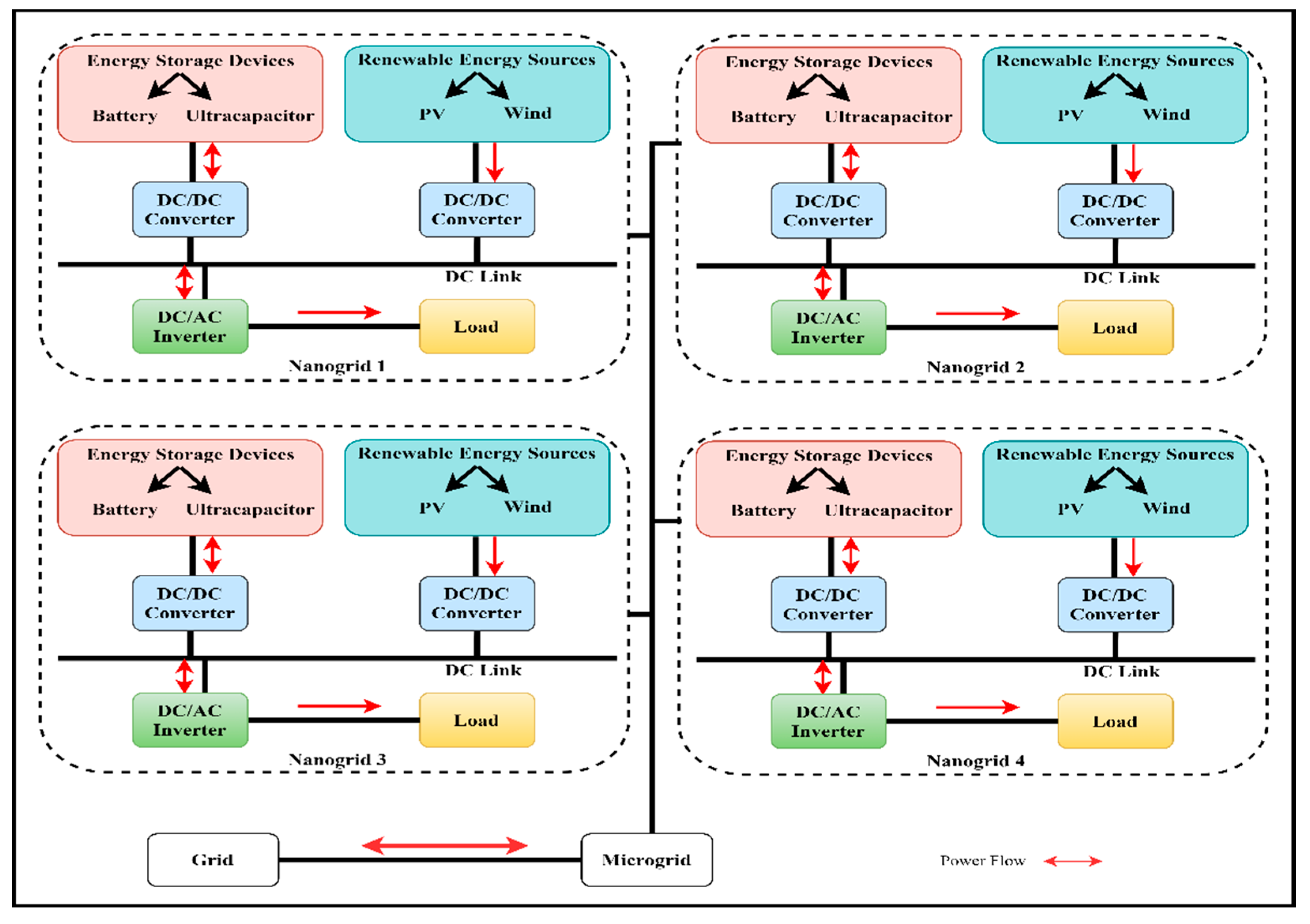
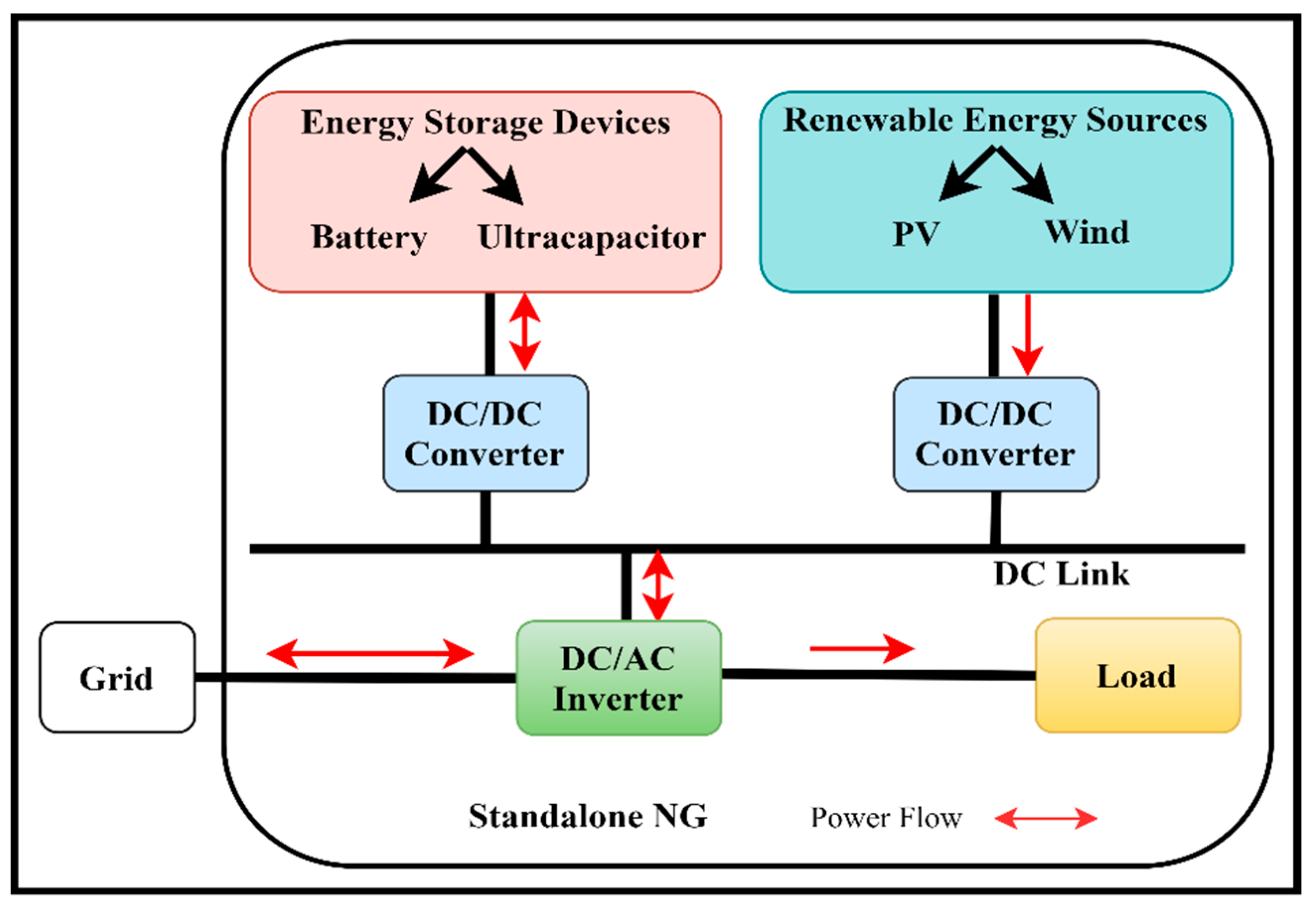
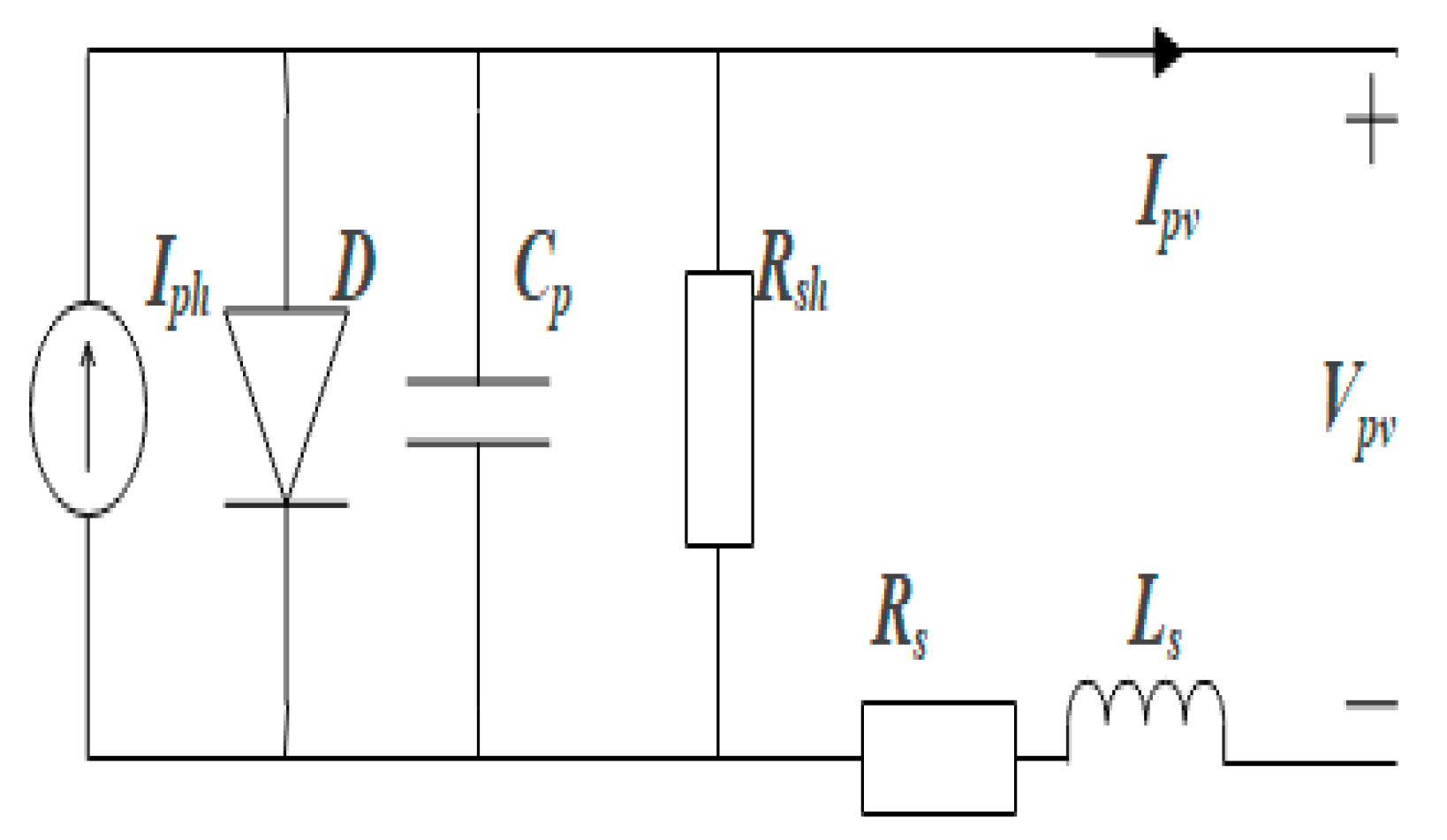
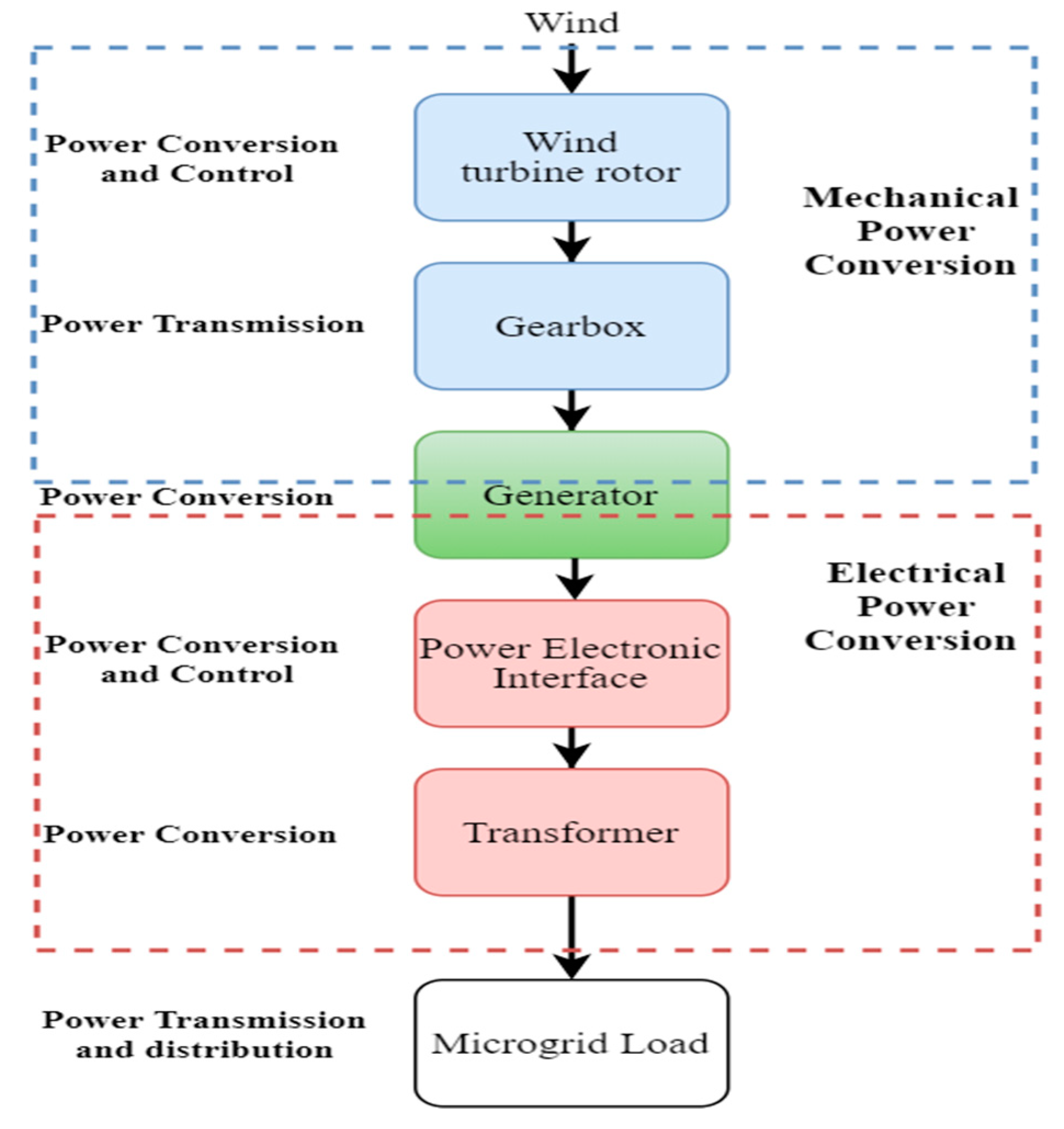

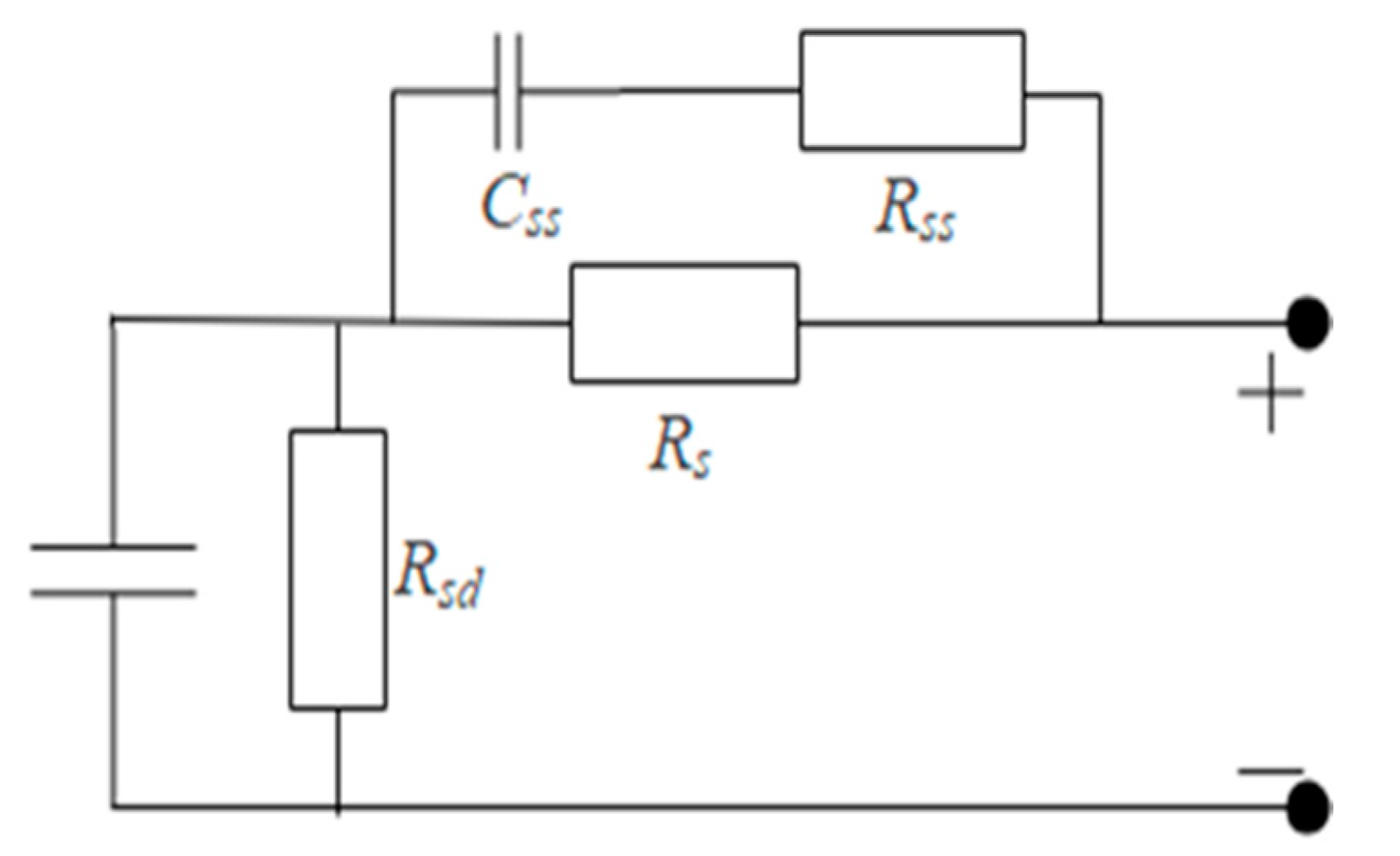
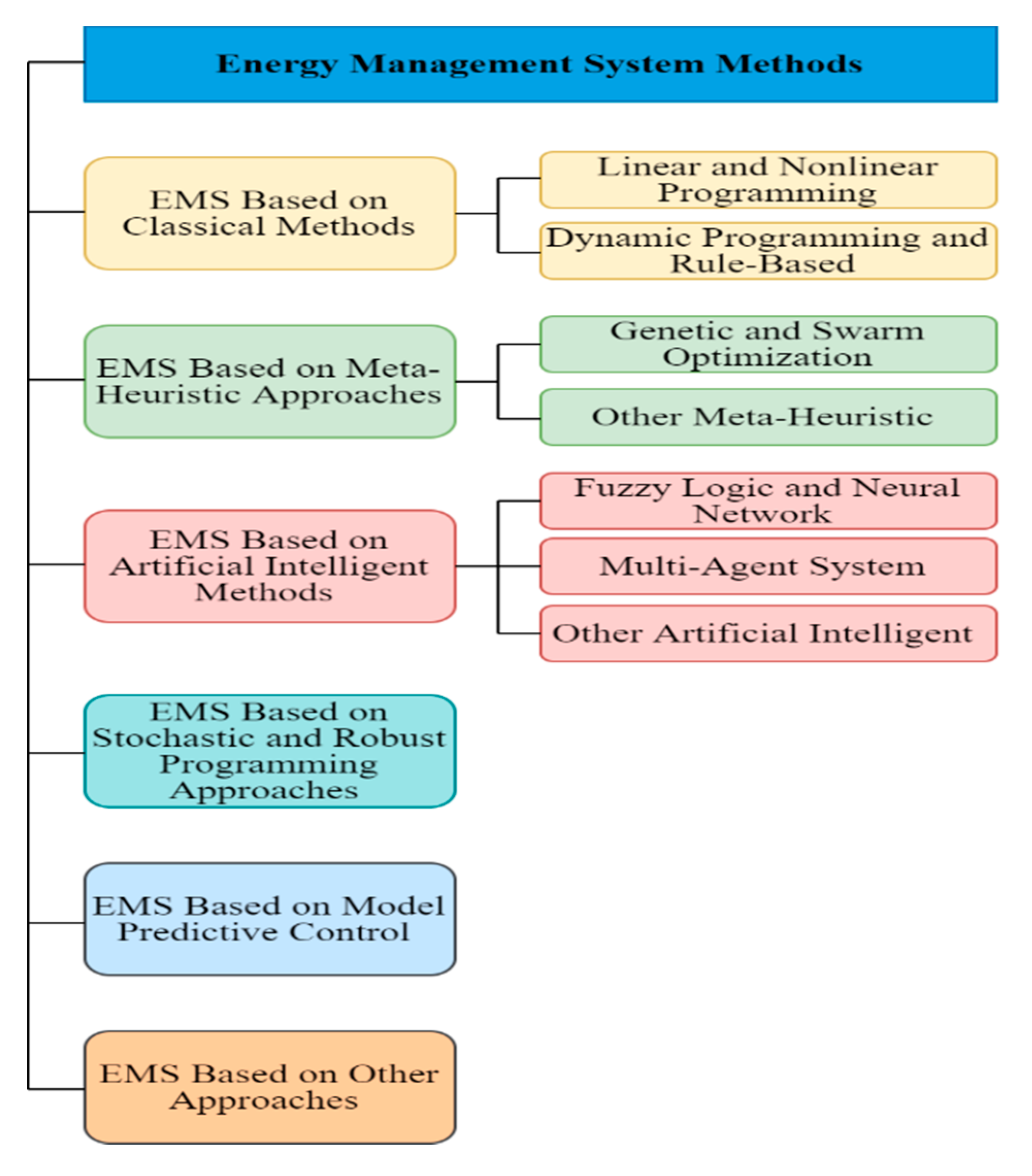
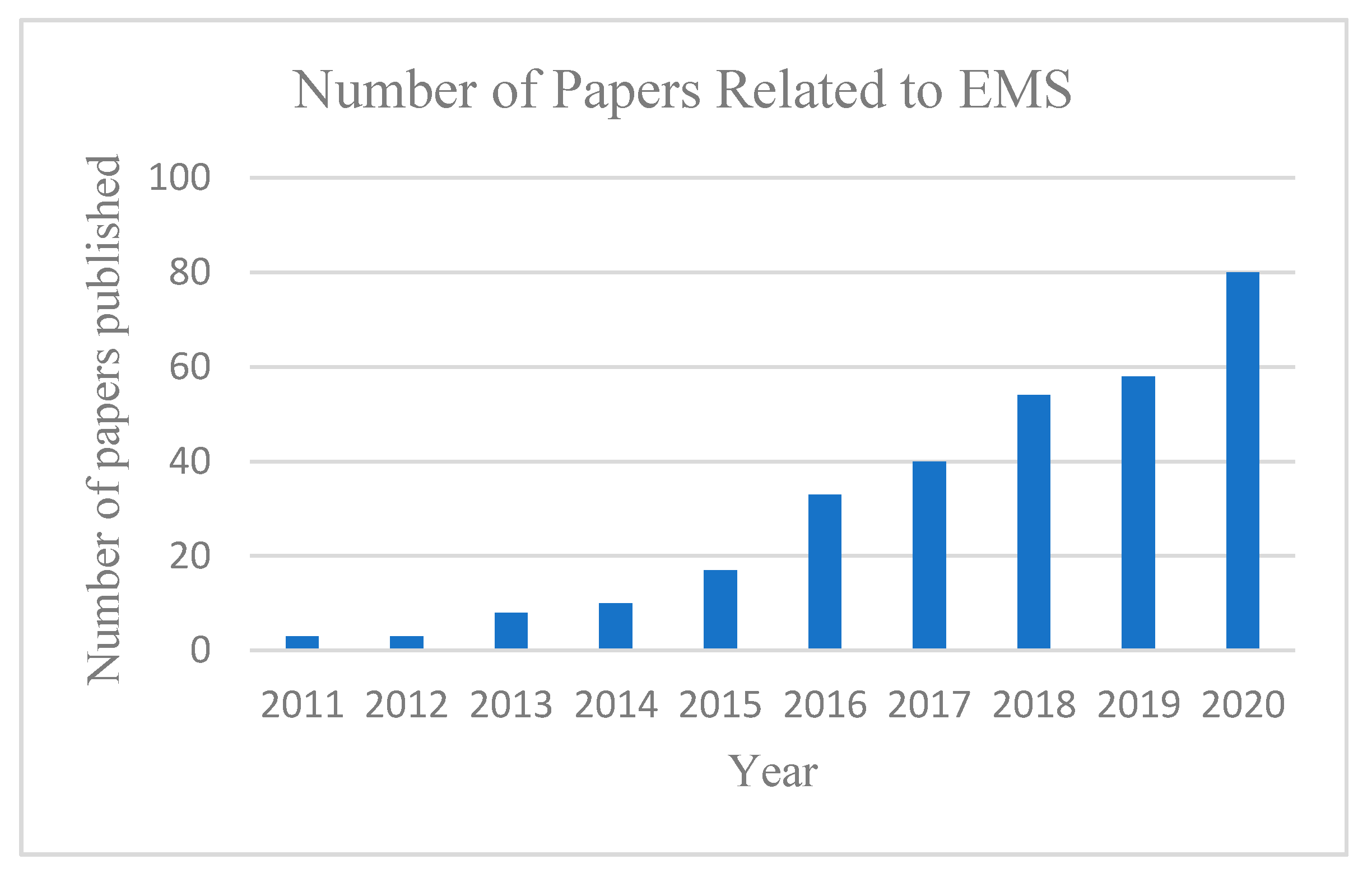
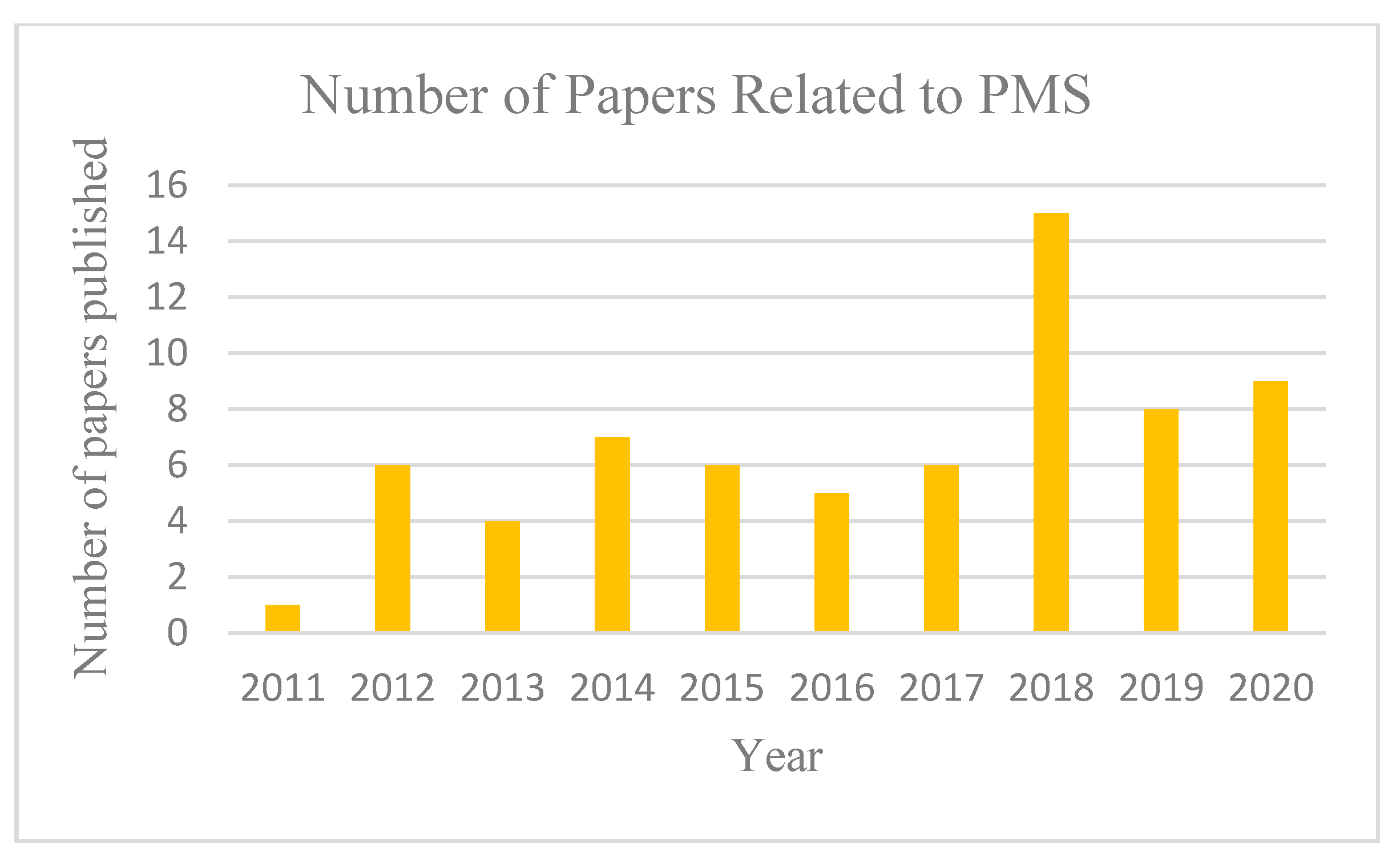
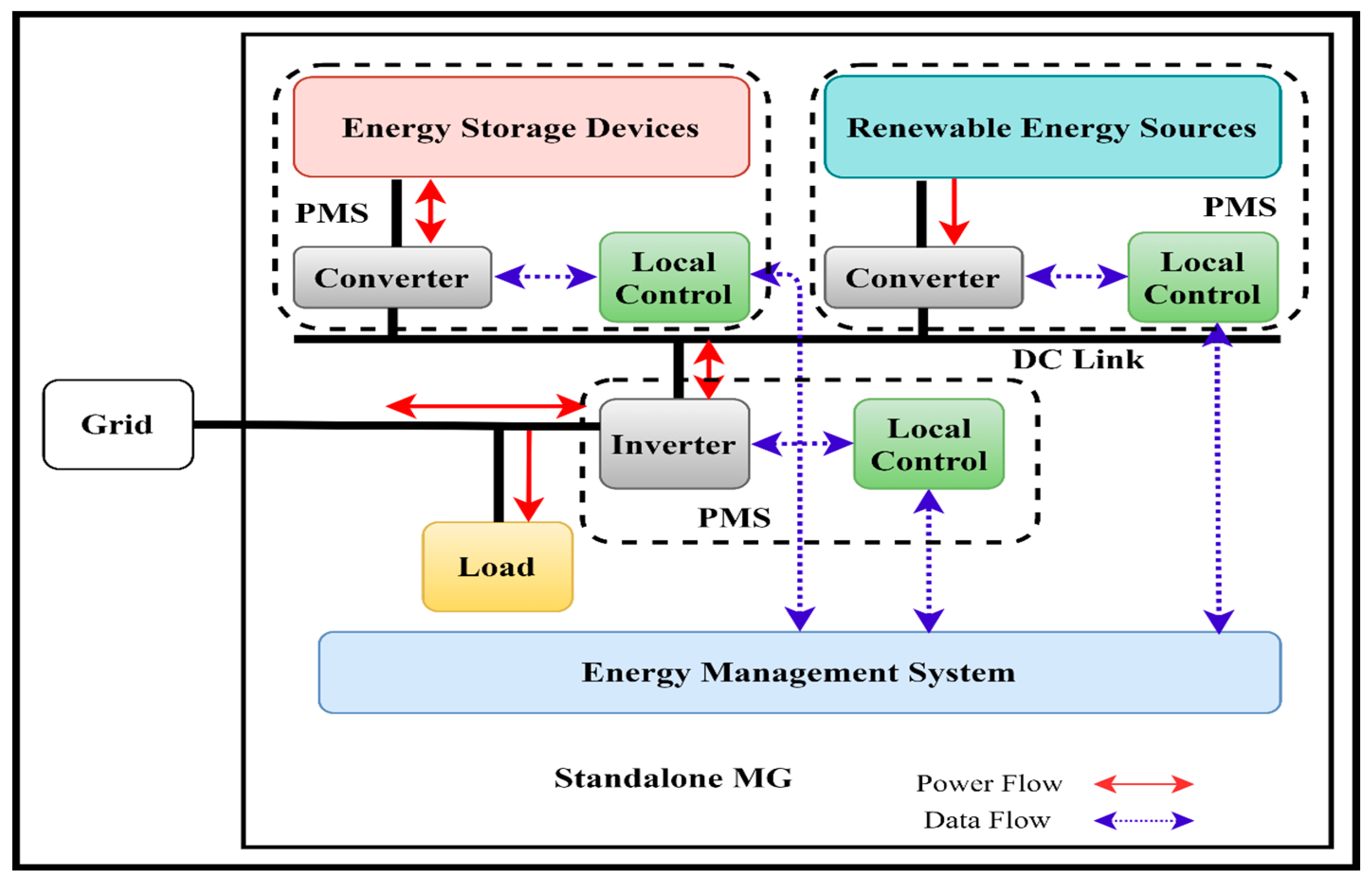
| References | Composition | Techniques | Objectives | Year |
|---|---|---|---|---|
| [45] | PV and diesel generator | MINLP | To decrease the daily operational costs | 2019 |
| [46] | PV, diesel generators, wind, fuel cells, microturbines, and battery | MINLP | To minimise the generation costs and amount of emissions | 2021 |
| [47] | PV and battery | MILP | To maximise the life span of the battery and minimise the operational costs | 2019 |
| [48] | PV and battery | MILP | To minimise the overall operational cost | 2021 |
| [49] | PV and battery | Non-linear Programming | To minimise the overall operational cost | 2019 |
| [51] | PV, fuel cell, and battery | Rule-Based | To maximise the life span of the battery | 2016 |
| [52] | Wind and batteries | Dynamic Programming | To increase the selling benefits of wind energy and minimise the costs of fulfilling the load demands in the MG | 2018 |
| [53] | PV, fuel cell, and battery | Stochastic Dynamic Programming | To minimise the overall operational cost | 2020 |
| [54] | PV, battery, and diesel generation | Dynamic Programming | To increase the PV energy utilisation and decrease fuel consumption | 2015 |
| [55] | PV, battery, and diesel generation | Dynamic Programming | To minimise CO2 emission costs and operational costs | 2015 |
| [56] | PV, battery, and diesel generation | Genetic Algorithm | To maximise the life span of the battery and minimise the operational costs | 2016 |
| [57] | PV, wind, fuel cell, battery, and diesel generation | BPSO | To minimise the grid energy consumption, minimise CO2 emission amount, and minimise the overall operational cost | 2019 |
| [58] | PV, wind, battery, and diesel generation | PSO | To minimise fuel costs and system capital costs | 2016 |
| [59] | PV, wind, diesel generator, and battery | Artificial Bee Colony | To decrease the energy costs | 2017 |
| [60] | PV, wind, microturbine, fuel cell, and battery | Grey Wolf | To minimise the emission of fuel sources and the operational costs of MG | 2018 |
| [61] | PV, wind, microturbine, and battery | Artificial Fish Swarm | To maximise the utilisation of renewable and non-renewable energy generation as well as better charge and discharge activities of the battery | 2018 |
| [62] | PV, wind, and battery | Multi-agent | To decrease operational costs from PV intermittency and the stochastic nature of the critical load | 2017 |
| [63] | PV, wind, fuel cell, and battery | Multi-agent | To maintain the balance between the energy demand and supply | 2016 |
| [64] | PV, wind, diesel generator, electrolyser, batteries, and fuel cells | Multi-agent | To maximise the utilisation of renewable and non-renewable energy generation and minimise the overall operational cost | 2015 |
| [65] | PV, wind, microturbine, fuel cell, and battery. | Multi-agent | To minimise the overall operational cost | 2014 |
| [66] | PV, wind, and battery | Fuzzy logic | To decrease the power fluctuations between the MG and main grids and increase the lifespan of the battery | 2017 |
| [67] | PV, wind, fuel cell, and battery | Fuzzy logic | To maximise the utilisation of renewable energy generation and maximise the lifespan of the battery | 2018 |
| [68] | PV, wind, fuel cell, microturbine, and battery | Fuzzy logic | To minimise the CO2 emission and operational costs of the MG | 2013 |
| [69] | PV, wind, microturbine, diesel generator, fuel cell, and battery bank | Neural Network | To minimise the overall MG costs in addition to the fuel costs, operational and maintenance costs, and the emission costs of the generator units | 2019 |
| [70] | PV, wind, batteries, and electrical cars | Neural Network | To maximise the power supplied by PV and wind and minimise the power import from the utility grid | 2015 |
| [71] | PV and microturbine | Game Theory | To maximise the MG profit exclusively with the prosumers | 2016 |
| [72] | Heating and power generation, wind, and battery | Rolling Horizon Markov | To reduce the gas costs and minimise the electricity costs | 2016 |
| [73] | PV, battery, and ultracapacitor | Rolling Optimisation | To decrease the power fluctuations between the NG and main grids and to improve battery charging and discharging activity | 2019 |
| [74] | PV, wind, battery, and ultracapacitor | Adaptive Intelligence | To maximise the utilisation of renewable energy generation, reducing the load fluctuations, and managing the system power dispatch | 2017 |
| [75] | PV and wind | Stochastic Method | To minimise the energy losses in MG and operational costs in the RES | 2017 |
| [76] | PV, wind, diesel generator, PEV, and batteries | Stochastic Method | To minimise the traditional generator operational costs, decreasing the commercial costs matching the grid energy and increasing the battery lifespan | 2014 |
| [77] | PV, battery, and PEV | Stochastic Method | To minimise the overall operational cost | 2017 |
| [78] | PV, wind, train station, and battery | Robust Optimisation | To minimise the overall operational cost | 2014 |
| [79] | PV, wind, and battery | Stochastic Method | To minimise the overall operational cost | 2019 |
| [80] | PV, wind, and battery bank | RMPC | To minimise the integrated economic operational costs | 2018 |
| [81] | PV, wind, diesel generator, fuel cell, and battery | MPC | To minimise the cost of energy demand and unit generation | 2018 |
| [82] | PV, wind, battery, and ultracapacitor | MPC | To minimise the operational costs and decrease the fluctuations between the MG and main grid | 2018 |
| [83] | PV, wind, diesel generator, and battery | MPC | To minimise the overall MG costs in addition to the fuel costs, operational and maintenance costs, and the emission costs of the generator units | 2017 |
| [84] | PV, and battery bank | Hierarchical Method | To minimise the energy cost and maximise the lifespan of the battery | 2018 |
| [85] | PV, turbine generation, and battery bank | Hierarchical Method | To minimise the emission and energy costs for the MG | 2017 |
| [86] | PV, wind, diesel generator, and batteries | Hierarchical Method | To minimise the energy cost and maximise the lifespan of the battery | 2016 |
| [87] | Wind | Game Theory | To optimise cost considering wind power uncertainties | 2021 |
| [88] | Smart grid | Game Theory | To reduce energy costs and regulate overall residential power requirements for several consumers sharing a common source system | 2010 |
| References | Composition | Techniques | Objectives | Year |
|---|---|---|---|---|
| [92] | PV and wind | MPC | To reduce the operational costs and ensure the power balance | 2019 |
| [93] | PV, wind, and battery | MPC | To minimise the energy costs and maximise the life span of the battery | 2013 |
| [94] | PV, fuel cells, electrolyser, and batteries | MPC | To minimise the use of traditional energy sources, saving energy after using RES, quality and economic factors using HESS | 2012 |
| [95] | PV, wind, combined heat power generation, microturbines, and boilers | Linear Programming | To minimise the emissions, overall costs, and demand payments | 2019 |
| [96] | PV, wind, and battery | Lyapunov Optimisation | To minimise the operational costs of the MG and maintain the outage possibility for quality usage | 2013 |
| [97] | PV, mechanical flywheel, and battery | Simultaneous Perturbation Stochastic Approximation | To acquire a smooth battery power profile and decrease the grid energy exchange | 2019 |
| [98] | PV, fuel cells, battery banks, and ultracapacitor | Dynamic Programming | To control the DC bus voltage and manage the amount of power shared between the load and MG | 2018 |
| [99] | PV, wind, and diesel generator | Fuzzy Logic | To improve the reliability of the system, and enhance the reactive and active power performance of the MG | 2016 |
| [100] | PV, wind, fuel cells, microturbines, and battery | Multi-agent | To ensure a safe, efficient, economical, and reliable operation of the MG system | 2017 |
| [101] | PV, batteries, and supercapacitor | Neural Network | To control the DC bus voltage and manage the amount of power shared between the load and MG | 2020 |
| [102] | PV, batteries, and supercapacitor | Neural Network | To minimise stress on the battery storage and maximise its lifespan | 2019 |
| [103] | PV, wind, fuel cells, electrolyser, and battery | Neural Network | To manage the output of the fuel cell and electrolyser to maintain the charge of a battery within a constant range | 2013 |
| References | Strategies | Power Management | Energy Management |
|---|---|---|---|
| [7,105] | Centralised Control | Based on PMS a centralised controller, developed for optimising low-voltage distribution network. The optimisation was carried out for the interconnected operations to maximise power exchange using the major distribution grid and optimise the output power for the local distributed generations (DGs). | A smart EMS (SEMS) for reducing the operational costs of MGs via optimal coordination of power production for DGs and ESSs. The researchers considered all economic and technical constraints for system development such as ESS management, power forecasting, economic load dispatch, and operational costs. |
| [106,107] | Decentralised Control | A simple decentralised framework for addressing the issues related to HESSs in direct current MG, like a violation of SOC, efficient power break, and deviation of bus voltage. Power fluctuations are controlled. The supercapacitors tackle the high-frequency power fluctuations, while the batteries tackle the low-power fluctuations. | A decentralised EMS for electric vehicle (EV) charging stations to control the flow of energy between the grid and MG. The DC bus voltage was a vital parameter for controlling the system. For maintaining the bus voltage at its reference value, the MPC is used for monitoring the SOC battery. The battery SOC presents the mode of PV operations, i.e., bus voltage sustaining mode, maximum power point tracking mode, or support of grid mode. |
| [108,109] | Distributed Control | A power distributed control process was proposed for sharing the load power in proportion to the distributed source ratings. Based on the instant power of the DGs, a voltage shift was applied to the DC bus voltage to compensate the voltage loss because of the droop controller and maintain the stability of the DC bus voltage irrespective of any changes in the load. | An EMS was developed for managing the HESS. The researchers proposed a new architecture based on the multi-agent system solution for applying important and sensitive loads. |
| [110,111] | Hierarchical Control | A solid-state transformer (SST)-enabled hierarchical PMS. The researchers assigned three-level functions, i.e., DC bus voltage recovery, local control, and controlling the SOC of the battery for each level. The MG operates reliably in the independent mode by using a primary control. The SST is seamlessly transferred via the enabled mode through a secondary control. | An EMS based on 2 level controls for the MG system composed of the ESS and PV was proposed. It aimed to manage the battery charging and discharging activities to prevent overcharging and discharging, and control SOC equalisation. |
Publisher’s Note: MDPI stays neutral with regard to jurisdictional claims in published maps and institutional affiliations. |
© 2021 by the authors. Licensee MDPI, Basel, Switzerland. This article is an open access article distributed under the terms and conditions of the Creative Commons Attribution (CC BY) license (https://creativecommons.org/licenses/by/4.0/).
Share and Cite
Jamal, S.; Tan, N.M.L.; Pasupuleti, J. A Review of Energy Management and Power Management Systems for Microgrid and Nanogrid Applications. Sustainability 2021, 13, 10331. https://doi.org/10.3390/su131810331
Jamal S, Tan NML, Pasupuleti J. A Review of Energy Management and Power Management Systems for Microgrid and Nanogrid Applications. Sustainability. 2021; 13(18):10331. https://doi.org/10.3390/su131810331
Chicago/Turabian StyleJamal, Saif, Nadia M. L. Tan, and Jagadeesh Pasupuleti. 2021. "A Review of Energy Management and Power Management Systems for Microgrid and Nanogrid Applications" Sustainability 13, no. 18: 10331. https://doi.org/10.3390/su131810331
APA StyleJamal, S., Tan, N. M. L., & Pasupuleti, J. (2021). A Review of Energy Management and Power Management Systems for Microgrid and Nanogrid Applications. Sustainability, 13(18), 10331. https://doi.org/10.3390/su131810331






